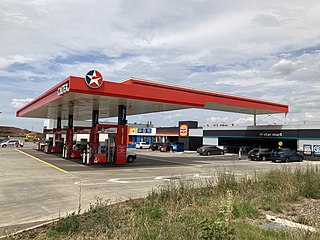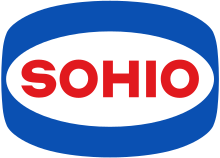Standard Oil Company, Inc., was an American oil production, transportation, refining, and marketing company that operated from 1870 to 1911. At its height, Standard Oil was the largest petroleum company in the world, and its success made its cofounder and chairman, John D. Rockefeller, among the wealthiest Americans of all time and among the richest people in modern history. Its history as one of the world's first and largest multinational corporations ended in 1911, when the U.S. Supreme Court ruled that it was an illegal monopoly.

Gulf Oil was a major global oil company in operation from 1901 to 1985. The eighth-largest American manufacturing company in 1941 and the ninth largest in 1979, Gulf Oil was one of the Seven Sisters oil companies. Prior to its merger with Standard Oil of California, Gulf was one of the chief instruments of the Mellon family fortune; both Gulf and Mellon Financial had their headquarters in Pittsburgh, Pennsylvania, with Gulf's headquarters, the Gulf Tower, being Pittsburgh's tallest building until the completion of the U.S. Steel Tower.
Texaco, Inc. is an American oil brand owned and operated by Chevron Corporation. Its flagship product is its fuel "Texaco with Techron". It also owned the Havoline motor oil brand. Texaco was an independent company until its refining operations merged into Chevron in 2001, at which time most of its station franchises were divested to Shell plc through its American division.

Amoco is a brand of fuel stations operating in the United States and owned by British conglomerate BP since 1998. The Amoco Corporation was an American chemical and oil company, founded by Standard Oil Company in 1889 around a refinery in Whiting, Indiana, and was officially the Standard Oil Company of Indiana until 1985. Originally part of the Standard Oil Company trust, it focused on producing gasoline for the new automobile market. In 1911, as part of the break-up of the Standard Oil trust, it became an independent corporation. Incorporated in Indiana, it was headquartered in Chicago, and formally adopted the name Amoco in 1985. Although the Amoco Corporation merged in 1998 into BP Amoco, the Amoco name was resurrected in 2017 as a brand that service station owners could choose to use when they purchased supplies from BP in selected areas of the United States.
ARCO is a brand of gasoline stations owned by Marathon Petroleum. BP, which formerly owned the brand, uses it in Northern California, Oregon and Washington, while Marathon has rights for the rest of the United States and Mexico.

A filling station is a facility that sells fuel and engine lubricants for motor vehicles. The most common fuels sold in the 2010s were gasoline and diesel fuel.

Esso is a trading name for ExxonMobil. Originally, the name was primarily used by its predecessor Standard Oil of New Jersey after the breakup of the original Standard Oil company in 1911. The company adopted the name "Esso", to which the other Standard Oil companies would later object.

Marathon Petroleum Corporation is an American petroleum refining, marketing, and transportation company headquartered in Findlay, Ohio. The company was a wholly owned subsidiary of Marathon Oil until a corporate spin-off in 2011.

200 Public Square is a skyscraper in Cleveland, Ohio. The building, located on Public Square in Downtown Cleveland, reaches 45 stories and 658 feet (201 m) with 1.2 million square feet (110,000 m2) of office space. It is the third-tallest building in Cleveland and fourth-tallest in the state of Ohio. The building opened in 1985 as the headquarters for Standard Oil of Ohio or Sohio, and was known as the Sohio Building or Standard Oil building. After British Petroleum (BP) rebranded Sohio as BP in the early 1990s, the building was often called the BP America Building, BP America Tower, BP Tower, or BP Building, and those earlier names are still regularly used even after BP moved its North American headquarters to Chicago in 1998. It was officially renamed 200 Public Square in 2005 and since 2010, has been Cleveland's regional headquarters for Huntington Bancshares.

Caltex is a petroleum brand name of Chevron Corporation used in the Asia-Pacific region, the Middle East, and Southern Africa. Headquartered in Singapore, it is also the brand name of non-Chevron petroleum companies in some countries under a trademark licensing agreement with Chevron.

Atlantic Petroleum was an oil company in the Eastern United States headquartered in Philadelphia, Pennsylvania, and a direct descendant of the Standard Oil Trust. It was also one of the companies that merged with Richfield Oil Corporation to form the "AtlanticRichfield Co.", later known as ARCO.

Big Oil is a name sometimes used to describe the world's six or seven largest publicly traded and investor-owned oil and gas companies, also known as supermajors. The term, particularly in the United States, emphasizes their economic power and influence on politics. Big Oil is often associated with the fossil fuels lobby and also used to refer to the industry as a whole in a pejorative or derogatory manner.

Humble Oil and Refining Co. was an American oil company founded in 1911 in Humble, Texas. In 1919, a 50% interest in Humble was acquired by the Standard Oil of New Jersey which acquired the rest of the company in September 1959. The Humble brand was used by Standard Oil of New Jersey until 1973, when the company rebranded nationwide as Exxon and discontinued Humble, along with its other brands Esso and Enco.

Kyso was an oil company, gasoline distributor, and direct descendant of Standard Oil that operated in the southeastern United States from 1886 until it was acquired by Standard Oil of California in 1961. After the breakup of Standard Oil in 1911, the company was awarded rights to run the oil operation of Kentucky, Georgia, Florida, Alabama, and Mississippi.

BP p.l.c. is a British multinational oil and gas company headquartered in London, England. It is one of the oil and gas "supermajors" and one of the world's largest companies measured by revenues and profits. It is a vertically integrated company operating in all areas of the oil and gas industry, including exploration and extraction, refining, distribution and marketing, power generation, and trading.

Enco was a secondary retail brand name for products of the Humble Oil Corporation in certain parts of the United States from 1960 to 1977. It was used on service stations operated by Humble in states where they were not permitted to use the Esso brand under conditions set by the court-ordered breakup of Standard Oil in 1911.
Gulf Oil LP is an American oil company formed when Chevron Corporation acquired the naming rights to the Gulf Oil brand in the United States for $13 billion in 1985.

Following the 1911 Supreme Court ruling that found Standard Oil was an illegal monopoly, the company was broken up into 34 different entities, divided primarily by region and activity. Many of these companies later became part of the Seven Sisters, which dominated global petroleum production in the 20th century, and became a majority of today's largest investor-owned oil companies, with most tracing their roots back to Standard Oil. Some descendants of Standard Oil were also given exclusive rights to the Standard Oil name.





















